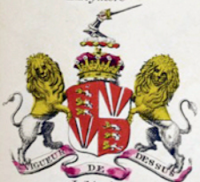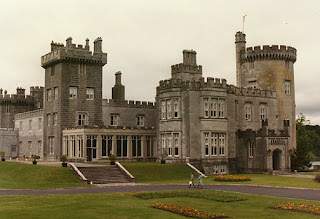This very ancient family claims royal descent, and deduces its pedigree from the celebrated Irish monarch, Brian Boru, who ascended the throne in 1002, and fell at the memorable battle of Clontarf, in 1014.
From this prince descended the Kings of Thomond; of which TURLOGH, King of Munster and principal High King of Ireland, had, with other issue, Dermot, King of Munster, from whom descended, in 1528, CONNOR O'BRIEN, King of Thomond, who married Anabella, youngest daughter of Ulick De Burgh, 1st Earl of Clanricarde, by whom he left four sons, in minority, at his decease, when the principality was usurped by his brother,
MURROUGH O'BRIEN, who, repairing to England by the advice of the Lord Deputy of Ireland, in 1543, surrendered his royalty to HENRY VIII, and was, in recompense, created Earl of Thomond for life, and BARON INCHIQUIN to his own heirs male.
His lordship wedded Eleanor, daughter of Sir Thomas FitzGerald, Knight, and dying in 1551, left issue,
DERMOT, his successor;His lordship was succeeded by his eldest son,
Teige.
DERMOT, 2nd Baron, who espoused Margaret, daughter of Donough O'Brien, 2nd Earl of Thomond.
He died in 1557, and was succeeded by his son,
MURROUGH McDERMOT, 3rd Baron (c1550-73), who wedded Mabel, daughter of Christopher, 6th Baron Delvin, and had issue,
MURROUGH, his successor;His lordship was slain by Dermot Reagh O'Shaughnessy in 1573, and was succeeded by his son,
Slaney.
MURROUGH, 4th Baron (1562-97), who wedded Margaret, daughter of Sir Thomas Cusack, LORD CHANCELLOR OF IRELAND.
His lordship fell from his horse and drowned, in 1597, when fording the River Erne, near Sligo, during the Nine Years War.
He was succeeded by his son,
DERMOT, 5th Baron (1594-1624), who wedded Ellen, eldest daughter of Sir Edmund FitzJohn FitzGerald, and had issue,
Henry;His lordship was succeeded by his youngest son,
Christopher;
MURROUGH, of whom we treat;
Honora; Mary; Ann.
MURROUGH (1618-74), 6th Baron, who was created, in 1654, EARL OF INCHIQUN.
 |
| Murrough, 1st Earl of Inchiquin (Image: Manchester Art Gallery) |
MURROUGH (1726-1808), 10th Baron, was created, in 1808, MARQUESS OF THOMOND.
The Castle is dominated by a tall, round corner tower and a square tower, both of heavily crenellated. There are also smaller towers and a turreted porch.
- Murrough O'Brien, 1st Marquess and 10th Baron (1726–1808)
- William O'Brien, 2nd Marquess and 11th Baron (1765–1846)
- James O'Brien, 3rd Marquess and 12th Baron (1768–1855)
Barons Inchiquin (1543; Reverted)
The 18th Baron's second cousin, Conor John Anthony O'Brien (born 1952), succeeds to the title.
- Lucius O'Brien, 13th Baron (1800–72)
- Edward Donough O'Brien, 14th Baron (1839–1900)
- Lucius William O'Brien, 15th Baron (1864–1929)
- Donough Edward Foster O'Brien, 16th Baron (1897–1968)
- Pádraig Lucius Ambrose O'Brien, 17th Baron (1900–82)
- Conor Myles John O'Brien, 18th Baron (1943-2023)
DROMOLAND CASTLE, Newmarket-on-Fergus, County Clare, is considered one of the finest examples of a baronial style castle in Ireland.
According to history, the original castle on the site is said to have dated back to the 11th century, and was more rustic in nature than the existing castle of today, similar in style to Bunratty castle.
Like other castles of the times, it served as a defensive stronghold.
From the time of Morrough O’Brien (the original owner of Dromoland) until the 16th Baron Inchiquin - who still owned the castle in the 1960s - the Inchiquins lived at Dromoland for more than 500 years.
In 1736, a second castle was built in the design of the Queen Anne period with a wing enclosing a central courtyard.
This wing of the castle remains today and is almost a century older than the other sections of the castle.
The present castle was completed in 1826 by the 4th O'Brien Baronet in Gothic style, with four large towers made of a dark blue limestone that was cut from a nearby quarry, and built at great expense for the times.
According to history, the original castle on the site is said to have dated back to the 11th century, and was more rustic in nature than the existing castle of today, similar in style to Bunratty castle.
Like other castles of the times, it served as a defensive stronghold.
From the time of Morrough O’Brien (the original owner of Dromoland) until the 16th Baron Inchiquin - who still owned the castle in the 1960s - the Inchiquins lived at Dromoland for more than 500 years.
In 1736, a second castle was built in the design of the Queen Anne period with a wing enclosing a central courtyard.
This wing of the castle remains today and is almost a century older than the other sections of the castle.
The present castle was completed in 1826 by the 4th O'Brien Baronet in Gothic style, with four large towers made of a dark blue limestone that was cut from a nearby quarry, and built at great expense for the times.
The windows on the main fronts are rectangular with Gothic tracery.
Inside, a square entrance hall opens into a long, inner hall similar to a gallery, the staircase being at one end; while the main reception rooms are at one side of it.
The rooms have quite austere ceilings with Gothic Tudor-Revival cornices.
The drawing-room was formerly called the Keightley Room since it contained many of the 17th century portraits which were acquired by the O'Brien family through the marriage of Lucius O'Brien MP to Catherine Keightley (whose grandfather was the Earl of Clarendon).
Part of the 18th century garden layout survives, including a gazebo and Doric rotunda.
During the latter portion of the 19th century, the Inchiquin family wealth dwindled due to a series of Land Acts, until Ireland seceded from the United Kingdom in 1921.
Landlords during this time were forced to sell their farmlands, and so the Inchiquins lost their main source of income.
However, they were able to still hold onto Dromoland.
Although the loss of income suffered by the Inchiquins made the Castle difficult to keep, they managed to do so, and the castle was maintained by the personal wealth of the 15th Baron's wife, and afterwards her son, the 16th Baron, until 1948, when they began to take in tourists as paying guests.
Finally, in 1962, the Castle was sold to an American industrialist, Bernard McDonough, whose family were of Irish descent.
Over a period of six months, the castle underwent major renovations and was eventually re-opened as a luxury hotel.
The original style and atmosphere of the castle are said to have been preserved, and the rooms including its stately, baronial country house atmosphere “look very much today, like they did when the Inchiquin family lived there... "
The original wing is very elegant inside: Guests enter into a two-storey stone lobby (made from the dark blue limestone) that is complete with suits of armour, a large dark wood carved table, elegant rose tapestry covered chairs, and dark red drapes.
On one side, a stone passage and hallway lead to the large, main drawing room of the castle.
The hallway and drawing-room have a high ceiling, deep red and gold wallpapered walls, and is lined with baronial portraits of the barons and former members of the Inchiquin family.
It is said that O'Brien family portraits (on loan) remain on display at the Castle today.
First published in April, 2011.





3 comments :
Very interesting article and I thank you for publishing it.
There is one correction and that is that the last Baron to live in the Castle was the 16th Baron, Donough and not the 17th and I think that you mean 500 years not 1000 living at Dromoland. However the O'Brien's technically controlled the lands at and around Dromoland from the times of Brian Boru and the Clan will be celebrating the Millennium of Brian's death in 2014.
Conor O'Brien, The O'Brien and 18th Baron Inchiquin.
Conor, did you ever live in the castle? Do you have memories of what it was like in the 1950's / 60's? Nice of you to post on the blog. VC
Sorry about the nickname but I dont know how to get rid of it!
I did live in the castle for a year as a child but we used to come most summers as a family as the 16th Barton was head of the family and it was his home. As you can imagine it was quite an experience for an adolescent and a different world in the 1950/60's to today.There are too may stories to tell about the Castle and maybe when I have a bit more time I will put some of them down on this blog.
Thomond house is on the hill overlooking the Castle and is a large by modern standards Georgian house built in 1963 by my Uncle.
Post a Comment